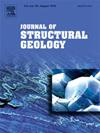Late Quaternary crustal shortening rate of the Wensu fault-bend fold in the southern Tian Shan, NW China
IF 2.9
2区 地球科学
Q2 GEOSCIENCES, MULTIDISCIPLINARY
引用次数: 0
Abstract
N‒S crustal shortening in the Tian Shan shows an obvious eastward decrease, which results in an eastward decrease in the width and uplift height of the topography. However, the highest peak in the Tian Shan region appears in its middle part (the Wensu area) instead of at the expected western end. At present, the kinematic information and N‒S crustal shortening rate of the Wensu foreland thrust system remain poorly constrained, which has led to controversy regarding the deformation characteristics and mechanism of geomorphic growth in this area. In this study, we focused on the kinematics and shortening rate of the Wensu fault-bend fold (WFBF), the frontal structural belt of the Wensu foreland thrust system. On the basis of interpretations of detailed high-resolution remote sensing images, field investigations, surveying of displaced terraces with an unmanned drone, the dating of late Quaternary sediments via OSL and trench excavation, we determined a relatively low N‒S crustal shortening rate of 1.31 ± 0.23 mm/yr over the past 24,000–40,000 years for the WFBF. We suggest that a listric thick-skinned fault geometry at depth results in more vertical uplift components, which is the key factor of significant topographic uplift amplitude in this region.
天山南缘文素断弯褶皱晚第四纪地壳缩短速率
天山南北向地壳缩短呈现明显的东缩趋势,导致地形宽度和隆升高度向东减小。然而,天山地区的最高峰出现在其中部(文苏地区),而不是在预期的西端。目前,对温素前陆冲断体系的运动学信息和南北地壳缩短速度知之甚少,导致该地区的变形特征和地貌生长机制存在争议。本文重点研究了温苏前陆冲断体系前缘构造带——断弯褶皱的运动学和缩短速率。基于详细的高分辨率遥感影像解译、野外调查、无人驾驶飞机对移位阶地的测量、晚第四纪沉积物的OSL测年和海沟挖掘,我们确定了WFBF在过去24,000-40,000年间相对较低的N-S地壳缩短速率为1.31±0.23 mm/yr。深部呈扁平状的厚皮断层几何形态导致了较多的垂向隆升分量,这是该区地形隆升幅度显著的关键因素。
本文章由计算机程序翻译,如有差异,请以英文原文为准。
求助全文
约1分钟内获得全文
求助全文
来源期刊

Journal of Structural Geology
地学-地球科学综合
CiteScore
6.00
自引率
19.40%
发文量
192
审稿时长
15.7 weeks
期刊介绍:
The Journal of Structural Geology publishes process-oriented investigations about structural geology using appropriate combinations of analog and digital field data, seismic reflection data, satellite-derived data, geometric analysis, kinematic analysis, laboratory experiments, computer visualizations, and analogue or numerical modelling on all scales. Contributions are encouraged to draw perspectives from rheology, rock mechanics, geophysics,metamorphism, sedimentology, petroleum geology, economic geology, geodynamics, planetary geology, tectonics and neotectonics to provide a more powerful understanding of deformation processes and systems. Given the visual nature of the discipline, supplementary materials that portray the data and analysis in 3-D or quasi 3-D manners, including the use of videos, and/or graphical abstracts can significantly strengthen the impact of contributions.
 求助内容:
求助内容: 应助结果提醒方式:
应助结果提醒方式:


